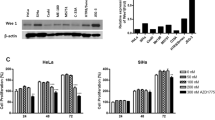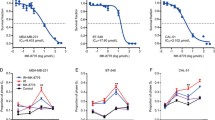Abstract
Dinaciclib is a selective cyclin-dependent kinase inhibitor, but its radiosensitizing effect remains unclear. The aim of this study is to investigate the radiosensitizing effect of Dinaciclib on cervical cancer cells. Two cervical cancer cell lines, Hela and Siha, were selected, and the IC50 was determined by CCK8. The radiosensitizing effect of Dinaciclib was verified by plate cloning assay, and the G2/M phase arrest and apoptosis of IR cells were verified by flow cytometry. Immunofluorescence assay was used to verify the formation of γH2AX foci following DNA damage. Western blot was performed to detect cell cycle, apoptosis, autophagy, and DNA damage-related pathways. Dinaciclib increased the cell sensitivity to IR. IR induced G2/M phase arrest and apoptosis, and Dinaciclib enhanced this effect. Further, Dinaciclib delayed DNA repair, including non-homologous end joining repair and homologous recombination repair, and reduced the expression of DNA repair proteins Ku80 (SiHa cells), Ku70, and RAD51, as well as the expression of apoptotic marker Bcl-2. The expression of autophagy marker Beclin1 induced tumor cell death and increased the formation of DNA damage marker γH2AX foci. Dinaciclib improves the sensitivity of cervical cancer cells to IR by inducing cell cycle arrest, delaying DNA repair, and increasing apoptosis. However, further research is needed to unravel the complexity of DNA repair pathways.






Similar content being viewed by others
Data availability
The datasets generated during and/or analyzed during the current study are available from the corresponding author on reasonable request.
References
Castle PE, Einstein MH, Sahasrabuddhe VV. Cervical cancer prevention and control in women living with human immunodeficiency virus. CA Cancer J Clin. 2021;71(6):505–26.
van den Akker MJE, Horeweg N, Beltman JJ, Creutzberg CL, Nout RA. Efficacy and toxicity of postoperative external beam radiotherapy or chemoradiation for early-stage cervical cancer. Int J Gynecol Cancer. 2020;30(12):1878–86.
Zhou J, Wu SG, Sun JY, Li FY, Lin HX, Chen QH, et al. Comparison of clinical outcomes of squamous cell carcinoma, adenocarcinoma, and adenosquamous carcinoma of the uterine cervix after definitive radiotherapy: a population-based analysis. J Cancer Res Clin Oncol. 2017;143(1):115–22.
Chen JL, Huang CY, Huang YS, Chen RJ, Wang CW, Chen YH, et al. Differential clinical characteristics, treatment response and prognosis of locally advanced adenocarcinoma/adenosquamous carcinoma and squamous cell carcinoma of cervix treated with definitive radiotherapy. Acta Obstet Gynecol Scand. 2014;93(7):661–8.
Barker HE, Paget JT, Khan AA, Harrington KJ. The tumour microenvironment after radiotherapy: mechanisms of resistance and recurrence. Nat Rev Cancer. 2015;15(7):409–25.
Kciuk M, Gielecinska A, Mujwar S, Mojzych M, Kontek R. Cyclin-dependent kinases in DNA damage response. Biochim Biophys Acta Rev Cancer. 2022;1877(3):188716.
Leal-Esteban LC, Fajas L. Cell cycle regulators in cancer cell metabolism. Biochim Biophys Acta Mol Basis Dis. 2020;1866(5):165715.
Raju U, Nakata E, Mason KA, Ang KK, Milas L. Flavopiridol, a cyclin-dependent kinase inhibitor, enhances radiosensitivity of ovarian carcinoma cells. Cancer Res. 2003;63(12):3263–7.
Dickson MA. Molecular pathways: CDK4 inhibitors for cancer therapy. Clin Cancer Res. 2014;20(13):3379–83.
Shapiro GI. Cyclin-dependent kinase pathways as targets for cancer treatment. J Clin Oncol. 2006;24(11):1770–83.
Fu W, Ma L, Chu B, Wang X, Bui MM, Gemmer J, et al. The cyclin-dependent kinase inhibitor SCH 727965 (dinacliclib) induces the apoptosis of osteosarcoma cells. Mol Cancer Ther. 2011;10(6):1018–27.
Premkumar DR, Jane EP, Thambireddy S, Sutera PA, Cavaleri JM, Pollack IF. Mitochondrial dysfunction RAD51, and Ku80 proteolysis promote apoptotic effects of Dinaciclib in Bcl-xL silenced cells. Mol Carcinog. 2018;57(4):469–82.
Zhao H, Li S, Wang G, Zhao W, Zhang D, Wang F, et al. Study of the mechanism by which dinaciclib induces apoptosis and cell cycle arrest of lymphoma Raji cells through a CDK1-involved pathway. Cancer Med. 2019;8(9):4348–58.
Criscitiello C, Viale G, Esposito A, Curigliano G. Dinaciclib for the treatment of breast cancer. Expert Opin Investig Drugs. 2014;23(9):1305–12.
Lin SF, Lin JD, Hsueh C, Chou TC, Wong RJ. A cyclin-dependent kinase inhibitor, dinaciclib in preclinical treatment models of thyroid cancer. PLoS One. 2017;12(2):e0172315.
Carey JPW, Karakas C, Bui T, Chen X, Vijayaraghavan S, Zhao Y, et al. Synthetic lethality of PARP Inhibitors in combination with MYC blockade is independent of BRCA status in triple-negative breast cancer. Cancer Res. 2018;78(3):742–57.
Washino S, Rider LC, Romero L, Jillson LK, Affandi T, Ohm AM, et al. Loss of MAP3K7 sensitizes prostate cancer Cells to CDK1/2 inhibition and DNA damage by disrupting homologous RECOMBINATION. Mol Cancer Res. 2019;17(10):1985–98.
Zhang M, Zhang L, Hei R, Li X, Cai H, Wu X, et al. CDK inhibitors in cancer therapy, an overview of recent development. Am J Cancer Res. 2021;11(5):1913–35.
Hossain DMS, Javaid S, Cai M, Zhang C, Sawant A, Hinton M, et al. Dinaciclib induces immunogenic cell death and enhances anti-PD1-mediated tumor suppression. J Clin Invest. 2018;128(2):644–54.
Cerciello F, Hofstetter B, Fatah SA, Zaghloul M, Odermatt B, Bodis S, et al. cell cycle checkpoint is functional in cervical cancer patients after initiation of external beam radiotherapy. Int J Radiat Oncol* Biol* Phys. 2005;62(5):1390–8.
Blachly JS, Byrd JC. Emerging drug profile: cyclin-dependent kinase inhibitors. Leuk Lymphoma. 2013;54(10):2133–43.
Parry D, Guzi T, Shanahan F, Davis N, Prabhavalkar D, Wiswell D, et al. Dinaciclib (SCH 727965), a novel and potent cyclin-dependent kinase inhibitor. Mol Cancer Ther. 2010;9(8):2344–53.
Xiao M, Zhang S, Liu Z, Mo Y, Wang H, Zhao X, et al. Dual-functional significance of ATM-mediated phosphorylation of spindle assembly checkpoint component Bub3 in mitosis and the DNA damage response. J Biol Chem. 2022;298(3):101632.
Okumura E, Sekiai T, Hisanaga S, Tachibana K, Kishimoto T. Initial triggering of M-phase in starfish oocytes: a possible novel component of maturation-promoting factor besides cdc2 kinase. J Cell Biol. 1996;132(1–2):125–35.
Gourley C, Balmana J, Ledermann JA, Serra V, Dent R, Loibl S, et al. Moving from poly (ADP-Ribose) polymerase inhibition to targeting DNA repair and DNA damage response in cancer therapy. J Clin Oncol. 2019;37(25):2257–69.
Paull TT. Mechanisms of ATM activation. Annu Rev Biochem. 2015;84:711–38.
Kozlov SV, Graham ME, Jakob B, Tobias F, Kijas AW, Tanuji M, et al. Autophosphorylation and ATM activation: additional sites add to the complexity. J Biol Chem. 2011;286(11):9107–19.
Marechal A, Zou L. DNA damage sensing by the ATM and ATR kinases. Cold Spring Harb Perspect Biol. 2013;5(9):a012716.
Weber AM, Ryan AJ. ATM and ATR as therapeutic targets in cancer. Pharmacol Ther. 2015;149:124–38.
Ray A, Mir SN, Wani G, Zhao Q, Battu A, Zhu Q, et al. Human SNF5/INI1, a component of the human SWI/SNF chromatin remodeling complex, promotes nucleotide excision repair by influencing ATM recruitment and downstream H2AX phosphorylation. Mol Cell Biol. 2009;29(23):6206–19.
Velic D, Couturier AM, Ferreira MT, Rodrigue A, Poirier GG, Fleury F, et al. DNA damage signalling and repair inhibitors: the long-sought-after achilles’ heel of cancer. Biomolecules. 2015;5(4):3204–59.
Zannini L, Delia D, Buscemi G. CHK2 kinase in the DNA damage response and beyond. J Mol Cell Biol. 2014;6(6):442–57.
Shiloh Y. ATM and ATR: networking cellular responses to DNA damage. Curr Opin Genet Dev. 2001;11(1):71–7.
Nie X, Guo E, Wu C, Liu D, Sun W, Zhang L, et al. SALL4 induces radioresistance in nasopharyngeal carcinoma via the ATM/Chk2/p53 pathway. Cancer Med. 2019;8(4):1779–92.
Panier S, Boulton SJ. Double-strand break repair: 53BP1 comes into focus. Nat Rev Mol Cell Biol. 2014;15(1):7–18.
Beskow C, Skikuniene J, Holgersson A, Nilsson B, Lewensohn R, Kanter L, et al. Radioresistant cervical cancer shows upregulation of the NHEJ proteins DNA-PKcs, Ku70 and Ku86. Br J Cancer. 2009;101(5):816–21.
Huang M, Miao ZH, Zhu H, Cai YJ, Lu W, Ding J. Chk1 and Chk2 are differentially involved in homologous recombination repair and cell cycle arrest in response to DNA double-strand breaks induced by camptothecins. Mol Cancer Ther. 2008;7(6):1440–9.
Funding
This work was supported by the Science and Technology Innovation Fund (Applied Basic Research) Project of Dalian City, Liaoning Province, China (Grant No. 2021JJ12SN40) and Validation project of artificial intelligence-assisted radioactive particle brachytherapy system for pelvic and abdominal tumors, Dalian City, Liaoning Province, China (Grant No. 2021JH1/10400051).
Author information
Authors and Affiliations
Contributions
All authors contributed to the study conception and design. Experimental design, data collation and analysis were performed by HZ, TC, YT and RM. Radiation therapy was performed by JZ during the experiment. The first draft of the manuscript was written by HZ and TC. LZ and HZ helped perform the analysis with constructive discussions. All authors commented on previous versions of the manuscript. All authors read and approved the final manuscript.
Corresponding author
Ethics declarations
Competing interests
The authors have no relevant financial or non-financial interests to disclose.
Additional information
Publisher's Note
Springer Nature remains neutral with regard to jurisdictional claims in published maps and institutional affiliations.
Rights and permissions
Springer Nature or its licensor (e.g. a society or other partner) holds exclusive rights to this article under a publishing agreement with the author(s) or other rightsholder(s); author self-archiving of the accepted manuscript version of this article is solely governed by the terms of such publishing agreement and applicable law.
About this article
Cite this article
Zhang, H., Chu, T., Zheng, J. et al. Sensitization of cervical cancer cells to radiation by the cyclin-dependent kinase inhibitor dinaciclib. Med Oncol 40, 68 (2023). https://doi.org/10.1007/s12032-022-01890-x
Received:
Accepted:
Published:
DOI: https://doi.org/10.1007/s12032-022-01890-x




